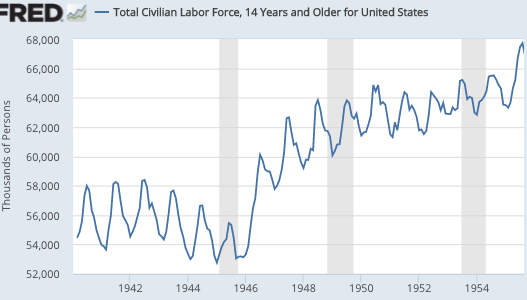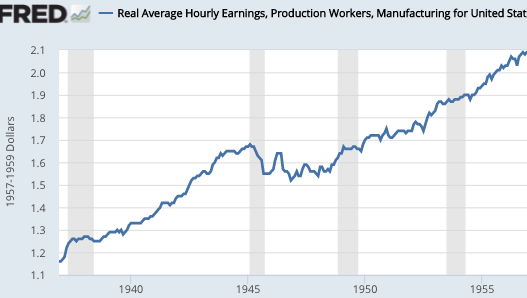An unruly debate over policy rules
George Selgin has a new piece criticizing Narayana Kocherlakota on policy rules. Here’s the intro:
I was just about to treat myself to a little R&R last Friday when — wouldn’t you know it? — I received an email message from the Brookings Institution’s Hutchins Center. The message alerted me to a new Brookings Paper by former Minneapolis Fed President Narayana Kocherlakota. The paper’s thesis, according to Hutchins Center Director David Wessel’s summary, is that the Fed “was — and still is — trapped by adherence to rules.”
Having recently presided over a joint Mercatus-Cato conference on “Monetary Rules for a Post-Crisis World” in which every participant, whether favoring rules or not, took for granted that the Fed is a discretionary monetary authority if there ever was one, I naturally wondered how Professor Kocherlakota could claim otherwise. I also wondered whether the sponsors and supporters of the Fed Oversight Reform and Modernization (FORM) Act realize that they’ve been tilting at windmills, since the measure they’ve proposed would only require the FOMC to do what Kocherlakota says it’s been doing all along.
So, instead of making haste to my favorite watering hole, I spent my late Friday afternoon reading,“Rules versus Discretion: A Reconsideration.” And a remarkable read it is, for it consists of nothing less than an attempt to champion the Fed’s command of unlimited discretionary powers by referring to its past misuse of what everyone has long assumed to be those very powers!
To pull off this seemingly impossible feat, Kocherlakota must show that, despite what others may think, the FOMC’s past mistakes, including those committed during and since the recent crisis, have been due, not to the mistaken actions of a discretionary FOMC, but to that body’s ironclad commitment to monetary rules, and to the Taylor Rule especially.
The post is much longer and provides a detailed rebuttal of Kocherlakota’s claims. Those who read George know that he is a formidable debater, and I end up much more sympathetic to his view that to Kocherlakota’s view of discretion. But it’s also important to be as generous to the other side as possible, so that their views don’t seem too outlandish. Here are two senses in which it might make sense to criticize the Fed for an excessively rules-based approach.
1. One criticism would be that the Fed was too tied to inflation targeting in 2008, when it would have been appropriate to also look at other variables. In that case, George and I would argue something closer to an NGDP target. But of course that’s not discretion, it’s a different rule.
2. Kocherlakota’s main objection seems to be that the Fed put too much weight on Taylor Rule-type thinking. One can certainly cite periods where money was (in retrospect) too tight, especially during and after 2008. And it’s very possible that the excessive tightness was partly related to Taylor Rule-type thinking. Thus I would not disagree with the claim that, at any given point of time, the Taylor Rule formula might lead to poor policy choices.
But in the end I don’t find his claim to be all that convincing. Selgin demonstrates fairly convincingly that while they may have occasionally paid lip service to Taylor Rule type thinking, they were in no sense following a specific instrument rule. John Taylor also makes this argument, and indeed criticized policy for being too expansionary during the housing boom. I’m going to try to better explain this distinction by reviewing the so-called “monetarist experiment” of 1979-82.
The conventional wisdom is that the Fed adopted money supply targeting in 1979, ran the policy for three years, and then abandoned it in 1982 due to unstable velocity. As always in macroeconomics, the conventional view is wrong. Just as wrong as the view that fiscal stimulus contributed to the high inflation of the 1960s, or that oil shocks played a big role in the high inflation of the 1970s, or that Volcker had a tight money policy during his first 18 months as Fed chair. Here’s what actually happened:
1. The Fed said it would start targeting the money supply, but it did not do so.
2. The Fed had a stop–go policy in 1979-81, and then a contractionary policy in 1981-82.
3. Velocity fell sharply in 1982, just as the monetarist model predicts.
The three-year “monetarist experiment” saw inflation fall from double digits to about 4%. That would be expected to reduce velocity. Friedman’s 4% money supply rule is supposed to work by keeping inflation expectations stable, so that velocity will be more stable. But inflation expectations were not kept stable during 1979-82, so the policy was never really tested long enough to see if it works.Having said that, I’d rather not give the 4% money growth rule a “fair test”, as that would take decades, and would probably result in the policy failing for other reasons. But 1979-82 told us essentially nothing about the long run effect of money supply targeting. It wasn’t even tried.
In a similar way, the Fed set interest rates far below Taylor Rule levels during the housing boom. So even if a momentary switch to Taylor Rule policy did occur during the housing bust, it’s not really a fair test of the policy. It’s be like driving rapidly toward the edge of a cliff, ripping off the steering wheel and handing it to the passenger, and then saying “OK, now you drive”.
Having said that, I also don’t favor the Taylor Rule. And even John Taylor is open to modifications based on new information as to the actual level of things like the equilibrium interest rate. When I’ve heard him talk, he’s actually calling on the Fed to adopt some sort of clear, transparent procedure for policy, so that when they make a move, it will be something the markets could have fully anticipated based on publicly available macro/financial data. In that case, I agree, which is why I am more sympathetic than many other economists to what the House is trying to do with its proposed Fed policy rule legislation.
If the Fed won’t adopt my futures targeting approach, then I’d at least like them to make their actual decision-making transparent. Show us the model of the economy, and the reaction function. If the model later has to be tweaked because of new developments in macro, that’s OK. Keep us abreast of how it’s being tweaked. If FOMC members use multiple models then show us each model, and set the fed funds target at the median vote. However they make decisions, Fed announcements should never be a surprise.
I’d also like to make a point about “rules” in the sense of policy goals, rather than instrument rules. People often seem to assume that NGDPLT is a “rule” in the same sense that 2% inflation targeting is a rule. Not so, NGDPLT is more rule-like that current Fed policy, in two important ways:
1. Any sort of NGDP targeting tells us exactly where the Fed wants the macro economy to be in the future, whereas 2% inflation targeting is much more vague. That’s because the dual mandate doesn’t tell us how much weight the Fed puts on inflation and how much they put on employment. Even worse, the Fed often predicts procyclical inflation, which would seem to violate the dual mandate. So it’s not at all clear what they are trying to do. Should the Fed try to push inflation a bit above 2% during periods of low unemployment, so that it averages 2% over the entire cycle? I don’t think so, but I have no idea what the Fed thinks, as they don’t tell us. With NGDP targeting it’s clear—aim for countercyclical inflation.
2. Going from NGDP growth rate targeting to NGDPLT, also makes policy much more rules based. Under NGDPLT, I have a very good sense of where the Fed wants NGDP to be 10 years from now. That helps us make more intelligent decisions on things like determining the proper yield on 10-year corporate bonds. If they miss the target on a given year, I know that they will aim to get back onto the old trend line. In contrast, the Fed currently doesn’t have any clear policy when they miss the target. Are they completely letting bygones by bygones, or do they aim to recover a part of the lost ground? I have no idea. It seems to vary from one business cycle to the next. In 2003-06 they regained ground lost in the 2001 recession, but in 2009-15 they did not do so.
I certainly also favor a policy rule for the instrument setting, but even if the instrument setting were 100% discretionary, I would view NGDPLT as an order of magnitude more rule-like than a “flexible” 2% inflation target, which also takes employment into account.





